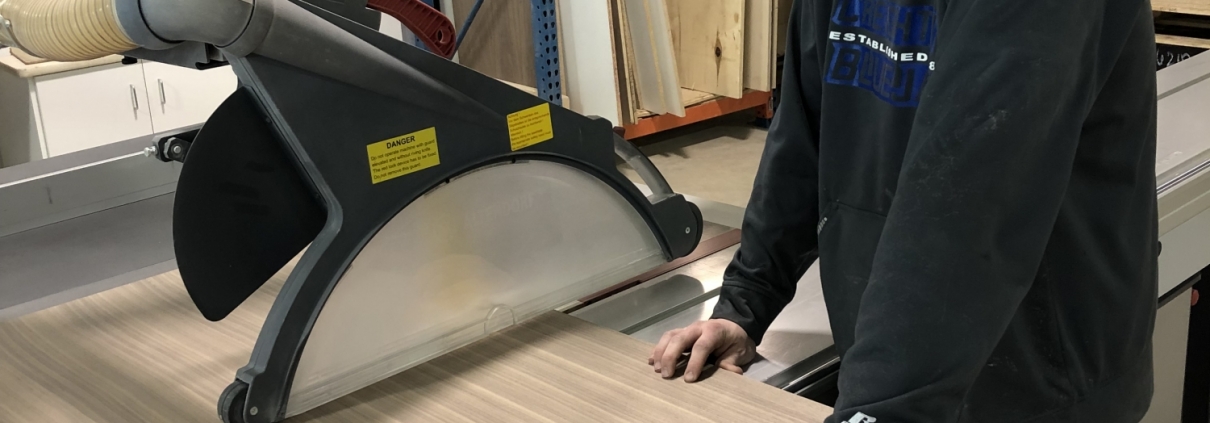Edu-Ind Partnership Launches Woodworking Careers
O’Keefe Millwork has found St. Paul College’s Cabinetmaking program to be a go-to source for woodworking talent.
In an era when wood product companies of all sizes, types and locales are hard-pressed to find employees, it comes as no surprise that St. Paul College’s Cabinetmaking Diploma program boasts 100 percent placement of its graduates.
“Those who want woodworking jobs are able to get jobs,” says Thomas Hlilstead, instructor of the one-year program that is an EDUcation™ member of the Woodwork Career Alliance of North America. “Demand is high right now. I have more companies calling me than I have students to fill their positions.”
One of St. Paul’s regular recruiters is O’Keefe Millwork of River Falls, WI, about a half-hour drive from St. Paul. O’Keefe, a member of the Architectural Woodwork Institute, employs nearly 60 people to manufacture architectural millwork, cabinetry and custom fixtures.
“I’d hire Tom’s entire class if I could,” says Jeff Stanway, plant manager of O’Keefe. “We’re always looking for employees. We could do more work right now if we could get more of the right people.”
Inside St. Paul’s Cabinetmaking Program
The average age of students enrolled in the St. Paul College Cabinetmaking program is 29. “We get some right out of high school and some retirees who are just looking to hone their woodworking skills, not to find employment,” Hillstead says. “Most of my students have been in the workforce. Many of them have a four-year college degree, but few took woodworking courses in high school. They come here looking to go in a different direction.”
The St. Paul Cabinetmaking program is designed to expose students to a wide-range of tools and equipment used by cabinet manufacturers, including portable power tools, table saws, edgebanders and CNC routers.
“We walk a fine line between what I call modern cabinetmaking and traditional cabinetmaking,” Hillstead says. “O’Keefe is an example of a shop with a lot of technology. They move a lot of products through their plant. Some of the other shops that hire my students are more traditional. They may be a two- or three-person maker’s-type shop where they make custom furniture pieces, and things like that. “My goal is that students leave here with enough skill sets to succeed in both of those environments.”
“When it comes to hands-on skills, I want to teach them about safety but I want them to be comfortable and know their limitations, too,” Hillstead adds. “We also work on the soft skills that will make them a good employee.”
Stanway says O’Keefe currently employs at least five graduates of Hillstead’s program. “They arrived easier to train than most of the people we hire off the street,” Stanway says. “They have chosen woodworking as a career and have gotten a good, well-rounded introduction to what the wood industry is all about. They’ve learned everything from how to read a tape measure all the way to being introduced to CNC.”
Stanway cites a couple of examples of O’Keefe employees who have more quickly advanced through the ranks because of the skills they learned at St. Paul College. “One started out in 2013 in cabinet assembly, but soon moved into custom assembly is now a lead builder. Another started in 2016 and now works in our custom department. We put in a new Homag widebelt sander a year-and-a-half ago and he’s one of the operators. He’s doing a great job,” Stanway says.
The WCA Connection
Hillstead has been a WCA accredited skill evaluator since 2012. Since then, he has evolved his curriculum by integrating the WCA Skills Standards and credentialing program.
“This school year we’ve redesigned the program to fully use the WCA Skill Standards as the basis for everything that the students learn. As they learn to run a boring machine, let’s say, I print out the sheets from the WCA Skill Standards on boring machines so that they can see exactly what’s expected to operate them.”
Hillstead says each student is required to purchase a WCA Passport membership at the start of the Fall semester. “They get tested to earn their Sawblade certificate in the fall on things like measurement, layout, the table saw, jointer, drill press, and sanding. They can be evaluated on more, but I don’t make it a requirement,” Hillstead says.
The Spring semester includes a class called Industrial Machining Methods. “This is where we get into some of the non-traditional equipment like edgebanders, CNC routers and the dowel insertion machine. Toward the end of the semester, a student can request to be evaluated on particular machine operations to earn additional tool stamps. I tell my students that their WCA credentials will give them a leg up in the job market,” Hillstead says.
“I think the WCA is a great program, for sure,” says Stanway, who is a member of the St. Paul College Cabinetmaking program advisory board. “We need more plant managers and department supervisors in the future and this program offers a great start.”
“O’Keefe is only one of the shops that we deal with, but they’ve been an awesome partner. They’ve been very supportive of our program including donating sheet goods and other materials, and organizing tours of their shop for our students,” Hillstead says. “Through his involvement on our advisory board, Jeff has helped guide our program to what the industry needs, and he’s also been a great advocate of our program and our involvement with the WCA.”




